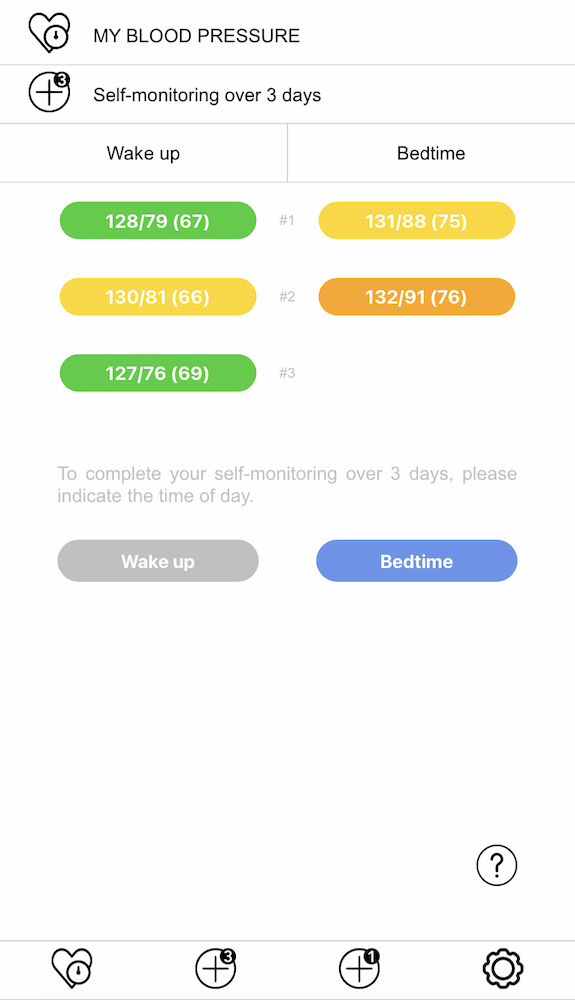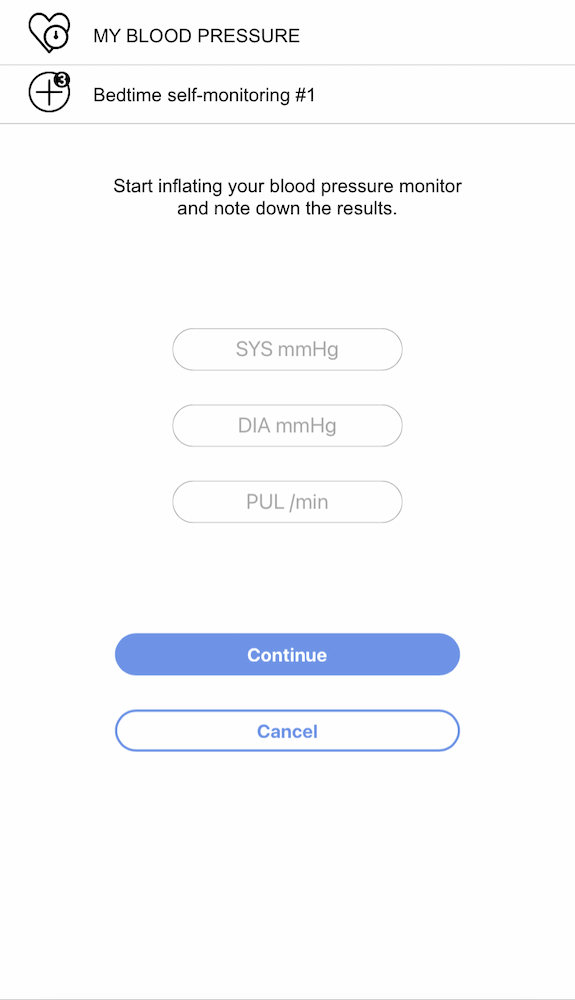| |
|
|
|
|
| |
Take care of your cardiovascular health by monitoring your blood pressure. |
|
| |
| |
We simplify your self-monitoring. |
|
| |
The My Blood Pressure app allows you to easily record your self-monitoring results. It will automatically calculate the averages and display the results in simple, easy-to-read graphs. Its use is completely intuitive. You just need to follow the step-by-step instructions, and we’ll take care of the rest.
|
|
| |
| |
You will be able to share your results. |
|
| |
You will have the possibility to invite trusted people, doctors or relatives, to follow your results. From anywhere and at any time, they will be able to view them without being able to modify them.
|
|
| |
| |
We ensure your security. |
|
| |
In order to ensure the security of your health data, no personal information will be requested. Your account will therefore be completely anonymous. We will provide you with a series of 8 four-digit codes, which will be your only identifiers to access your account. You must carefully keep them and only use them in case of an unexpected disconnection or device change. Since we do not know who you are, you will not receive any advertisements from us or through our intermediaries.
|
|
| |
| |
All this at a competitive price. |
|
| |
Using the My Blood Pressure service requires an annual subscription of 24.00 EUR, which is only 2.00 EUR per month.
|
|
|
|
| |
| |
32 user reviews ⭐️ ⭐️ ⭐️ ⭐️ ⭐️ 4.8 |
|
| |
Thomas, Germany
6 months ago
⭐️ ⭐️ ⭐️ ⭐️ ⭐️
Very handy, very good
Didier, France
6 months ago
⭐️ ⭐️ ⭐️ ⭐️ ⭐️
Very happy to have found this site ;)
Jean Louis, France
7 months ago
⭐️ ⭐️ ⭐️ ⭐️
Easy to use. Correct results
David, United Kingdom
7 months ago
⭐️ ⭐️ ⭐️ ⭐️ ⭐️
At this price, it would be a shame to pass it up... it's really good!
Marco, Italy
7 months ago
⭐️ ⭐️ ⭐️ ⭐️ ⭐️
Very good!
Anne-Françoise, France
8 months ago
⭐️ ⭐️ ⭐️ ⭐️ ⭐️
Really very practical and easy to use
Francesca, Italy
8 months ago
⭐️ ⭐️ ⭐️ ⭐️ ⭐️
Perfect !
Sofie, Belgium
9 months ago
⭐️ ⭐️ ⭐️ ⭐️ ⭐️
It works very well ;)
Phil, France
9 months ago
⭐️ ⭐️ ⭐️ ⭐️ ⭐️
What a relief to have found this tool!
Klaus, Germany
9 months ago
⭐️ ⭐️ ⭐️ ⭐️
Works well, easy to use and really practical
Luc, France
10 months ago
⭐️ ⭐️ ⭐️ ⭐️ ⭐️
Awesome 👍
Annelies, Netherlands
10 months ago
⭐️ ⭐️ ⭐️ ⭐️ ⭐️
Really great! Soon a Dutch version?
Pierre, France
10 months ago
⭐️ ⭐️ ⭐️ ⭐️ ⭐️
Very good app, at least I no longer make mistakes calculating averages 😆
Gwen, France
11 months ago
⭐️ ⭐️ ⭐️ ⭐️ ⭐️
Practical, reliable and inexpensive
Petra, Germany
11 months ago
⭐️ ⭐️ ⭐️ ⭐️ ⭐️
Usage is super easy, the results are clear and very reliable!
Geneviève, Switzerland
11 months ago
⭐️ ⭐️ ⭐️ ⭐️ ⭐️
Very easy to use, the graph is very understandable and my doctor thinks it's great :)
Laurent, France
1 year ago
⭐️ ⭐️
Pointless
Jürgen, Germany
1 year ago
⭐️ ⭐️ ⭐️ ⭐️ ⭐️
Super easy, works reliably and really helpful !
T, Spain
1 year ago
⭐️ ⭐️ ⭐️ ⭐️ ⭐️
Very good !
Anne, France
1 year ago
⭐️ ⭐️ ⭐️ ⭐️ ⭐️
Perfect
Patrizio, Italy
1 year ago
⭐️ ⭐️ ⭐️ ⭐️
Works well, almost perfect.
Katarzyna, Poland
1 year ago
⭐️ ⭐️ ⭐️ ⭐️
Very practical. Too bad there is no Polish version.
Christine, France
1 year ago
⭐️ ⭐️ ⭐️ ⭐️ ⭐️
Honestly, super practical. I can check my blood pressure every month without stress, it's clear and quick.
Antonio, Portugal
1 year ago
⭐️ ⭐️ ⭐️ ⭐️ ⭐️
Super easy to use and reliable
Pat, France
1 year ago
⭐️ ⭐️ ⭐️ ⭐️ ⭐️
Very nice! Makes taking my measurements easier :)
Peter, United Kingdom
1 year ago
⭐️ ⭐️ ⭐️ ⭐️ ⭐️
Perfect !
Sandrine, France
1 year ago
⭐️ ⭐️ ⭐️ ⭐️ ⭐️
Perfect ! I'm terrible at math, this is a lifesaver.
Lucia, Spain
1 year ago
⭐️ ⭐️ ⭐️ ⭐️
Honestly, it's not bad
Jean Marc, France
1 year ago
⭐️ ⭐️ ⭐️ ⭐️ ⭐️
Good app, really easy to use, charts are easy to read.
Philippe, Belgium
1 year ago
⭐️ ⭐️ ⭐️ ⭐️ ⭐️
Simple and effective!
Sophie, France
1 year ago
⭐️ ⭐️ ⭐️ ⭐️ ⭐️
Really good value for money.
André, France
1 year ago
⭐️ ⭐️ ⭐️ ⭐️ ⭐️
Perfect
❮
❯
|
|
| |
| |
Start for free. |
|
| |
Before committing, you will benefit from a 30-day free trial allowing you to record your first self-measurement.
|
|
| |
|
|
| |
| |
| |
How to monitor your blood pressure ? |
|
| |
| |
If you suffer from blood pressure disorders… |
|
| |
Whether you are undergoing medical treatment or not, it is important to monitor your blood pressure yourself to track its progression. These self-monitoring are generally repeated every month, but only your doctor will tell you how often you need to do them. Each self-monitoring measurement should be performed under the same conditions : ⸱ by following the rule of 3; ⸱ by relaxing beforehand; ⸱ by settling into a specific position.
|
|
| |
| |
What is the rule of 3 ? |
|
| |
Taking a single self-monitoring measurement doesn't really make sense, as it only reflects your blood pressure at a specific moment. The rule of 3 involves measuring your blood pressure 3 times in the morning, 3 times in the evening, for 3 consecutive days, each time under the same conditions. By calculating the averages of wake up and bedtime, you'll get reliable and consistent results.
|
|
| |
| |
Relax before you begin. |
|
| |
Rest for 5 to 10 minutes before taking your blood pressure. Avoid consuming coffee, smoking, or engaging in physical effort in the previous 30 minutes. Settle in a quiet place, free of stress and distractions. During the measurement, do not talk, move, or contract your muscles, especially in your arm.
|
|
| |
| |
How to sit properly ? |
|
| |
Sit comfortably in a chair, with your back straight and supported by the backrest. Place your feet flat on the floor, do not cross your legs. Place the cuff around your bare arm, about 1" (2-3 cm) above the elbow crease. Make sure it is snug but not too tight: you should be able to slip a finger between your arm and the cuff. Rest your arm on a table or armrest so that it is at heart level. If you are using a wrist monitor, place it at heart level. Your palm should be facing upward.
|
|
| |
| |
| |
To better understand blood pressure. |
|
| |
| |
The heart, a pressure pump ? |
|
| |
We all know that the heart is a muscular pump that circulates blood through the arteries and then throughout our body. When it contracts, it ejects blood. This is the systolic phase. And when it relaxes, it fills with blood. This is the diastolic phase.
|
|
| |
| |
A bit like a bike pump ? |
|
| |
We have all experienced plugging the tip of a bicycle pump with our finger. When we press the pump, we feel pressure, similar to cardiac systole. And when we release the pump, the pressure decreases, similar to cardiac diastole.
|
|
| |
| |
And what about blood pressure ? |
|
| |
Blood pressure follows the same principle of force exerted by the heart on the blood, and consequently on the arteries. It is measured in two values: systolic pressure (when the heart contracts) and diastolic pressure (when it relaxes).
|
|
| |
| |
How is blood pressure measured ? |
|
| |
The unit of pressure measurement used is millimeters of mercury (mmHg). A good blood pressure is around 120/80 mmHg (120 for the systolic phase and 80 for the diastolic phase).
|
|
| |
| |
Why measure your blood pressure ? |
|
| |
Measuring your blood pressure helps detect abnormalities such as hypertension and hypotension, and monitor heart rate. Therefore, it allows you to keep track of your cardiovascular health.
|
|
| |
| |
What is hypertension ? |
|
| |
Hypertension is defined as a blood pressure value exceeding 140/90 mmHg. This elevated blood pressure can damage arteries, increasing the risk of cardiovascular diseases such as heart attacks (myocardial infarction), strokes, or kidney failure.
|
|
| |
| |
What is hypotension ? |
|
| |
Hypotension is defined as a value below 90/60 mmHg. This low pressure can reduce blood flow to organs, causing dizziness, fainting, or serious complications if vital organs are poorly perfused.
|
|
| |
| |
What is heart rate ? |
|
| |
Heart rate refers to the frequency and regularity of the heart's beats. It corresponds to the number of times the heart contracts in one minute to pump blood throughout the body. It is measured at rest and in beats per minute (bpm). In an adult, a normal heart rate typically ranges between 60 and 100 bpm. Bradycardia refers to an abnormally slow heart rate (less than 60 bpm). This may be normal in athletes but can also be associated with issues such as electrical problems in the heart. Tachycardia refers to a fast heart rate (more than 100 bpm). It can be caused by stress, illness, or a heart abnormality. Arrhythmia refers to irregular heartbeats. It can result from an electrical disorder in the heart, which may be benign or require medical intervention. It cannot be measured by a blood pressure monitor and requires medical supervision.
|
|
| |
| |
| |
The causes of hypertension and hypotension. |
|
| |
| |
What are the common factors ? |
|
| |
There are numerous causes of hypertension or hypotension, some of which are common : ⸱ advanced age: Blood vessels lose their elasticity, which can lead to hypertension or hypotension. ⸱ nutrient-poor diet: Deficiencies in sodium (hypotension) or excess salt intake (hypertension). ⸱ substance consumption: Caffeine, tobacco, alcohol, or drugs. ⸱ environmental factors: Excessive heat, which promotes dehydration.
|
|
| |
| |
Other factors for hypertension ? |
|
| |
Additional factors related to hypertension may include a genetic predisposition, a sedentary lifestyle, being overweight or obese, or chronic stress. There may also be secondary causes such as chronic kidney disease, sleep apnea, hormonal disorders, pregnancy, and the use of certain medications (some contraceptives, non-steroidal anti-inflammatory drugs, or decongestants).
|
|
| |
| |
Other factors for hypotension ? |
|
| |
There are numerous causes explaining hypotension, such as dehydration, hemorrhage, sepsis, endocrine, or neurological disorders. Severe allergic reactions and the use of certain medications such as diuretics, antidepressants, drugs treating Parkinson's disease, and even those treating hypertension (excessive intake) can also be added.
|
|
| |
| |
| |
Recognize the signs of hypertension or hypotension. |
|
| |
| |
What are the symptoms ? |
|
| |
A failing blood pressure does not always come with symptoms, and that's the real problem. Some people may remain asymptomatic due to their body's gradual adaptation to these conditions. On the other hand, a sudden drop or rise in blood pressure can cause immediate symptoms.
|
|
| |
| |
How to recognize hypertension ? |
|
| |
Hypertension is often referred to as the "silent killer" because many people have no symptoms. When present, possible symptoms include headaches (especially in the morning), dizziness, blurred vision (or visual disturbances), shortness of breath, or even chest pain in severe cases.
|
|
| |
| |
How to recognize hypotension ? |
|
| |
Hypotension more often causes symptoms because it can reduce blood flow to the brain and vital organs, leading to dizziness or lightheadedness, fainting, general fatigue, blurred vision, nausea, or difficulty concentrating.
|
|
| |
| |
How to be sure ? |
|
| |
It's very simple, if you have never been diagnosed with hypertension or hypotension, check your blood pressure two or three times a year. You can do it at home using a blood pressure monitor, preferably an electronic one with automatic inflation on the arm. But the ideal solution is to ask your doctor. If they detect hypertension or hypotension, they will be the key figure in helping you regain correct blood pressure.
|
|
| |
| |
| |
What to do in case of blood pressure issues ? |
|
| |
| |
Consult your doctor. |
|
| |
The doctor plays the main role in the treatment of hypertension and hypotension. Only they can determine the causes of this failure and suggest the most appropriate medical treatment. They may also refer you to other specialist doctors to more accurately assess your health based on their specialties.
|
|
| |
| |
Adopt a healthy lifestyle. |
|
| |
In case of hypertension, reduce salt intake, prioritize fruits, vegetables, whole grains, and foods low in saturated fats. Exercise regularly (at least 30 minutes per day). Manage your stress (meditation, yoga, relaxation). Avoid tobacco and limit alcohol consumption. In case of hypotension, drink enough water (2 to 3 liters per day) and consume electrolyte-rich drinks if needed. Divide your meals to avoid energy drops and slightly increase salt intake in your diet (with your doctor's approval). Avoid standing up too quickly after sitting or lying down. Wear compression stockings, they help improve blood circulation.
|
|
| |
| |
Monitor your blood pressure. |
|
| |
At home, take your blood pressure regularly. Your doctor will tell you how often, but generally, one self-measurement per month will be enough (following the rule of 3). These regular self-measurements are essential to track the evolution of your blood pressure and adjust your medical treatment if necessary. Our site is designed to help and make it easier for you to take your self-measurements. It will also allow you to share your results directly with your doctor.
|
|
| |
| |
| |

|

|

|

|
© 2025 Trinop
All Rights Reserved
|
|
|









